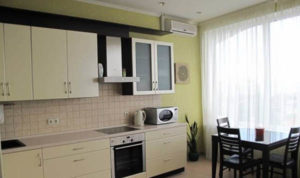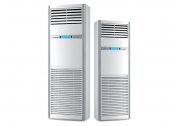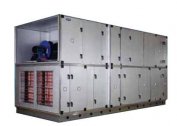In the kitchen, people spend most of their time, especially if it is a living room concurrently. Cooking is associated with increased heat, plus a working refrigerator, microwave, oven. In the summer in such a room it is difficult and dangerous to health. Air conditioning is the only way out. The split system in the kitchen is relevant both in a private house and in an apartment - concrete walls do not contribute to heat dissipation, even if there is access to the balcony.
The kitchens of restaurants and cafes are constantly working industrial ovens. Create a comfortable environment for the work of staff - the primary task of management. For restaurants, more powerful devices are selected - for example, fan coil units mounted in a ventilation system for supplying fresh air and air conditioning.
What is air conditioning in the kitchen for?
There are several good reasons to install air conditioning in the kitchen in an apartment or private house:
- Expensive household appliances will overheat and wear less. This applies to refrigerators and freezers, the load on which in the warm season increases.
- Storing perishable foodstuffs is not safe in the summer, as pathogens multiply faster, toxins can lead to poisoning and costly treatment.
- Reducing the number of harmful insects that enter the room through open windows.
- In autumn and spring, without air conditioning and heating, humidity rises, which contributes to the appearance of mold on the walls. Air conditioning for the kitchen, which has a heating function, is turned on in the off-season and dries the air. The manufacturer's manual allows you to turn on the equipment at temperatures above 0 degrees, so there will be no problems with operation.
- Models with air ionizers are good for your health. They purify and saturate the air with particles that accelerate metabolism. Ionization is a two-way process; it has both positive and negative sides. Before deciding to buy an air conditioner with an ionizer, you need to weigh the pros and cons.
- People with a tendency to allergic diseases need air conditioning in the kitchen to periodically purify the air of all kinds of allergens in plastic and food. For this purpose, it is recommended to additionally install a hood to reduce the load on the split system and remove kitchen odors, as well as to prevent the absorption of aromas in clothes and hair, which is a common problem for housewives.
It is worth paying attention to models with additional functions developed by manufacturers specifically for the kitchen - this is a photocatalytic filter with a list of useful properties:
- protects air from cigarette smoke;
- cleans of burning and soot;
- neutralizes toxic compounds;
- destroys viruses, bacteria and fungal spores.
The novelty is based on the action of a chemical reaction catalyst - titanium oxide. Thanks to it, harmful substances do not accumulate in the system, but are immediately destroyed.
Which model to choose
Several models of climatic equipment are suitable for the kitchen:
- Window. These are obsolete designs, but many prefer them for country houses, so as not to overpay for expensive equipment. Of the benefits, only the cost. There will be problems with tightness, the noise level is high. It is uncomfortable to be in a room with a working window air conditioner.
- Mobile devices that cool the air.Of the positive aspects - a small size, the ability to remove if necessary or move to another room. They are divided into monoblocks, in which both nodes are in the same case, and portable split systems. The principle of operation of monoblocks is that the air from the room is removed to the street, installation is not required, there is no refrigerant, the appearance of the facade is not disturbed, the walls do not deteriorate. Of the disadvantages - noise, the need to install near windows or ventilation, a higher cost than split systems.
- Portable split systems are not much different from wall-mounted domestic air conditioners. Of the advantages - the lack of installation work, greater productivity compared to the monoblock, less noise, easy to transport. Design flaws are manifested in the need to remove condensate manually, the inability to install blocks far from each other. Portable models are suitable for rented apartments, where there is no way to install a stationary kit.
With permanent residence in a private house or apartment, you need to choose and install an ordinary household split-system with a photocatalyst. This model will please you with its qualities more than once and will last for a long time provided that it is installed and serviced properly.
Requirements for a kitchen split system
Air conditioning in the kitchen must meet all safety and comfort requirements. Before buying, you should consult with a specialist who will assess the installation options, floor space, number of working appliances in the kitchen or dining room. According to preliminary results, power and other equipment parameters can be foreseen in advance.
What to consider:
- Since the air conditioner in the kitchen will be serviced more often, access to it should be free - the system should not be blocked by furniture or textiles.
- Ease of removal of filters and their cleaning. Fine filters are not recommended as they clog for one week.
- Access to the external unit. It is good if you can get there yourself without resorting to the services of installers for a simple cleaning procedure.
An air conditioner that switches to heating mode is a good solution for the kitchen, allowing you not to accumulate humidity and condensation on the walls.
If there is a desire to deliver a more environmentally friendly unit, you need to choose according to the type of coolant - old type freon or newer. This point must be taken into account immediately, since subsequently it will be impossible to fill in another substance - the systems are designed for one type of refrigerant. Installation of pipes and checking for leaks is a prerequisite. New fluids have higher pressures, so leaks are possible.
Automatic power reduction of the device allows saving on electricity. When there is a cooking process, the heat transfer increases, you need to turn on the equipment at full capacity. The rest of the time, the air conditioner operates as usual. Room temperature is controlled by sensors.
Air flow direction is an important point. The location of the indoor unit is chosen away from the table or crowded places.
The power of the kitchen air conditioner is determined by the principle of + 100% of the necessary for this room. Not only the area is taken into account, but also the maximum heat transfer from appliances, the main of which are the stove and oven. Calculation example:
- for a room of 10 square meters. meters need 1 kW of power;
- for the kitchen on 10 square meters. m - 2 kW.
According to reviews of people who installed air conditioners with an estimated capacity of + 15% margin, this was not enough for the kitchen at rush hour. Those who chose models that exceeded the required power by 2 times were pleased with the results.





